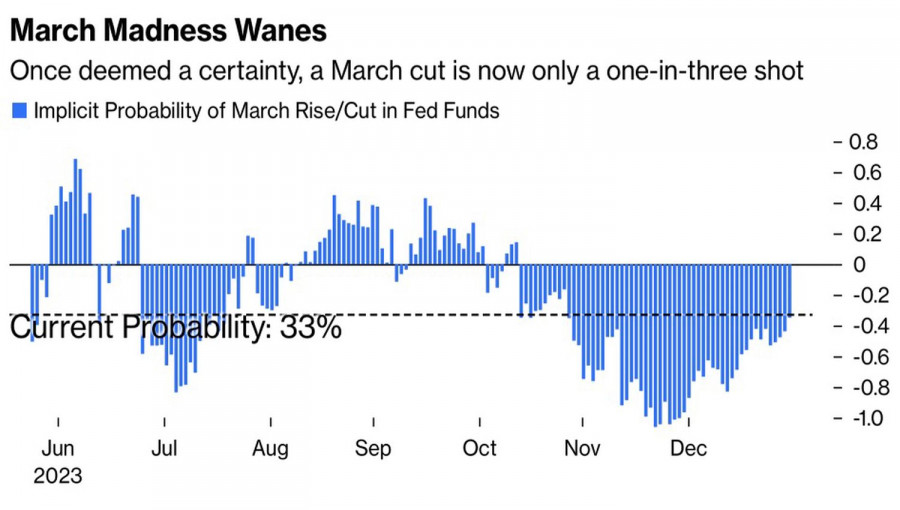Federal Reserve Chairman Jerome Powell stated that a rate cut in March is not the baseline scenario for the central bank. The drop in U.S. stock indices and the decline of EUR/USD below the 1.08 mark seemingly prove that investors took this message seriously. However, the chances for March fell only to 33%, after which the indicator rose to 37%. The futures market is not giving up the idea of starting monetary expansion in the first month of spring. This circumstance allows the major currency pair to maintain a tendency towards consolidation.
Probability of a Fed rate cut in March

It's one thing to speculate about Jerome Powell's assumptions and those of his colleagues, and another to look at actual data. In the context of the Fed's monetary policy dependence on incoming macro statistics, it is not surprising that investors decided to hedge their bets. They did not rush headlong into short positions on EUR/USD, preferring to wait for the U.S. labor market report for January. Will it clarify everything? Judging by the choppy dynamics of the major currency pair, I am beginning to doubt it.
Euro is supported by the statements of European Central Bank Chief Economist Philip Lane and not as sharp a slowdown in European inflation as one might have expected. According to Lane, eurozone companies should sacrifice high profits to restrain inflationary pressure. If they do this, even high wage growth rates will not accelerate the CPI. The idea seems doubtful, but the ECB's focus on wages suggests that it will prefer to ease monetary policy later rather than sooner.
Especially since consumer prices in the currency bloc slowed down to 2.8% in January, and core inflation to 3.3% on an annual basis. Both indicators turned out to be higher than Bloomberg expert consensus forecasts, allowing us to say that the deflation process in the eurozone is progressing more slowly than experts expect.
European inflation dynamics

Derivatives still indicate a 90% probability of the ECB starting monetary expansion in April and expect a 150 bps reduction in the deposit rate to 2.5% in 2024. In my opinion, European Central Bank President Christine Lagarde and her colleagues will not move so quickly, ultimately providing support for the euro.
The Bank of England contributed to the return of EUR/USD to the trading range of 1.080–1.085. It kept the repo rate at 5.25%, but two MPC members immediately voted for a 25 bps increase. The market expected only one "hawk" to remain. As a result, the pound strengthened and pulled up the regional currency. Both are pro-cyclical and often move in the same direction.
Technically, on the daily chart of EUR/USD, there were unsuccessful breakouts of the upper boundary of the consolidation range at 1.080–1.085 and then the lower boundary. The strategy that took into account this scenario turned out to be financially successful. Why not use it again?
The material has been provided by InstaForex Company - www.instaforex.comfrom Forex analysis review https://ift.tt/L3swpF4
via IFTTT
